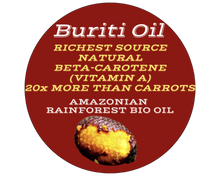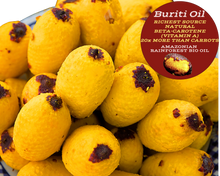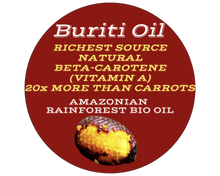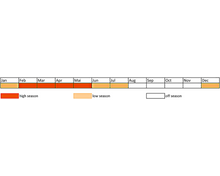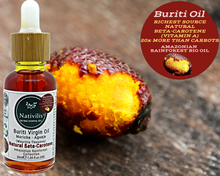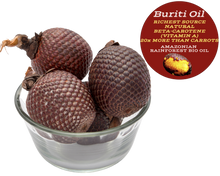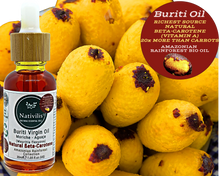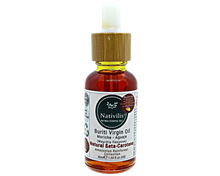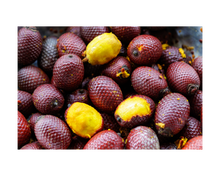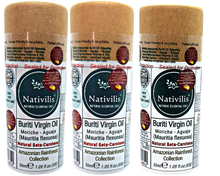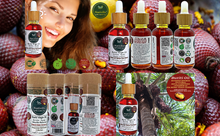
Nativilis Amazonian Buriti Oils (Mauritia flexuosa) Moriche – Aguaje – Richest source Beta-Carotene Vitamin A 20X More than Carrots – emollient rebuild moisturize re-hydrate skin cells - Copaiba
Nativilis Amazonian Buriti Oils (Mauritia flexuosa) Richest source Beta-Carotene Vitamin A 20X More than Carrots – emollient rebuild moisturize re-hydrate skin cells – Copaiba
Nativilis Buriti-Öle aus dem Amazonas (Mauritia flexuosa) Reichste Quelle Beta-Carotin Vitamin A 20-mal mehr als Karotten – weichmachend, regenerierend, feuchtigkeitsspendend, rehydrierend für Hautzellen – Copaiba
HARVEST PERIOD

PHYSICAL-CHEMICAL DATA AND APPLICATIONS
The buriti oil (Mauritia flexuosa) is very rich in oleic acid (72,5%), a type of monounsaturated fatty acid that is much present in olive oil, which is associated with a lower incidence of coronary heart disease. Furthermore, it is considered to be the richest natural source in beta carotene (30 milligrams/100 g pulp), exceeding 20 times of carrot. The beta carotene is one of the most powerful antioxidants, known for its large capacity for cell renewal, serves as an excellent natural skin peeling. Due to its ability to absorb radiation in the range of visible light and ultraviolet, the oil serves the cosmetics industry as an efficient solar filter that reduces the dryness of the skin. In anti-aging formulations increases the elasticity of the skin.

POPULAR USAGE
The buriti is a palm with multiple use. New leaves and their stalks are frequently employed in crafts, in the confection of baskets, the fruit pulp is processed into a juice called “wine” and sweets, which constitutes quite appreciated food in the Amazon region. The buriti oil, which is edible, is used in frying and applied on the skin against sunburns causing immediate relief and helping the healing. Due to its powerful detoxifying and allergic combating effects the caboclos treat snake and scorpion bites through the application of oil on the wound as well as intake of half a spoon of oil, and against asthma the daily intake of half a spoon of oil reduces the cough and relieve breathing. Currently, the fruit pulp is commercialized in local markets of the countryside for the production of “wine” that replaces açaí during the rainy period, from January to June, the low peak production period of açaí. There are companies which sell the fresh fruit pulp for the extraction of oil, and others prefer the dry pulp, called buriti flour, because the pulp is very perishable.
Benefits Nativilis Amazonian Buriti Oils (Mauritia flexuosa) Moriche – Aguaje for skincare:
- Reduces the appearance of fine lines and wrinkles.
- Helps in lightening dark spots caused by sun exposure.
- Restores skin elasticity.
- Protects the skin against photo-damage.
- Helps to protect the membranes surrounding skin cells which keep the skin cells healthy for longer.
- Great emollient properties which help to rebuild, moisturize and rehydrate skin cells.
- Anti-inflammatory properties help combat skin conditions such as redness, rashes, sensitive skin, roughness and irritation.
Composition Nativilis Amazonian Buriti Oils (Mauritia flexuosa) Moriche – Aguaje:
Richest natural source of beta-carotene – known as an excellent natural antioxidant. It is this high natural beta-carotene concentration that protects the skin against photo-damage and, also helps to protect the membranes surrounding skin cells, which keeps the skin cells healthy for longer.
Rich in unsaturated fatty acids and contains vitamins E and A which promotes great emollient properties, which help to rebuild, moisturize and rehydrate skin cells.
What is Nativilis Amazonian Buriti Oils (Mauritia flexuosa) Moriche – Aguaje used for?
Buriti oil can be used in many skincare formulations including:
- Body and facial cleansers.
- Body and facial moisturizers.
- Haircare preparations especially for those with dry, brittle and damaged hair.
- Lip care.
It can be used by all skin types but is particularly suited for dry, mature and aging skin, eczema, psoriasis and other skin conditions.
References:

ECOLOGY
Buriti (moriche) is a palm tree (Mauritia flexuosa), which dominates expansive areas and covers nearly all central Brazil and the southern Amazonian lowland streams. It is an elegant tree that can reach up to 35 meters in height. Forms large leaves with a rounded crown. The flowers are yellowish colored and appear from December to April. It’s fruit-shaped ellipsoidal, chestnut color, and has a surface coated with shiny scales. The yellow flesh covers a hard oval seed, whose almond is edible, and fruiting occurs from December to June. The buriti palm naturally occurs alone or in communities, which require an abundant supply of water in the soil.
For this reason, they dominate in floodplains and swamps where the soil is soft and moist, which is a secure indication of the existence of a watercourse. Where they settled the water carried and spread over the floating seeds. The palm is a dioecious species, plants that form male and female individuals. Only those with female flowers fructify.
Around 60 female and 80 male buriti palms can be found in a hectare. An adult palm can produce up to 200 kg of fruit, which can be processed in 30 kg of flour or finally extracted into 5 to 6 liters of oil (flour contains 22% of oil). Assuming an average of 60 buriti palms per hectare 300 to 360 liters of oil can be achieved. The productive cycle is repeated every two 2 years, but there are communities that manage their natural buriti palm areas by cutting and withdrawing small and dried bunches and weeding of natural competitors and thus have a year with low and the other with high productivity. Complementary studies are needed for soil and climate to know if this management is responsible for the decline of the productive cycle.
The rainforest is still destroyed for short term profits – for unsustainable timber exploration and slash-and- -burn activities for low valuable cash cropping and cattle farming. A highly promising alternative is the purchase of non-timber products such as seeds and fruits. The collection of the seeds is carried out with the involvement of the local forest communities cultivating partnerships driven by fairness, transparency, respect, and ethics. Thus, we can assure that the sourcing practices are in strict compliance with the respect of traditional knowledge, for the environment, and guarantee its full traceability. Nativilis advocates the preservation of the Amazonian Rainforest by promoting the use and creating consumer markets for these sustainable and renewable rainforest resources, which contribute to poverty alleviation and local development. You are most invited to learn more about the Amazonian biodiversity
-
-
Nativilis Amazonian Buriti Oils (Mauritia flexuosa) Moriche – Aguaje – Richest source Beta-Carotene Vitamin A 20X More than Carrots – emollient rebuild moisturize re-hydrate skin cells - Copaiba
-
Scientific name: Mauritia flexuosa
- Part Used of the plant: Fruit pulp
- Production Process: Cold Extraction
-
Cultivation: Wild
-
Country of Origin: Brazil
-
Major Compounds: : Mauritia flexuosa Insigns high oleic acid content (65.6%), followed by palmitic acid (19.2%), and smaller fractions of the fatty acids linolenic, linoleic, stearic, and myristic. (See the Certification of Analysys)
- Blends well with: Copaiba.
- Source of raw material: Amazonian Rainforest / Brazil
- Batch number: AMO 021 - 003/062021
- Preservatives: Absent
- Number of analysis: 198/2021
- Solvent extraction: Absent
- date: 05/06/2021
- Origin of the vegetable drugs: Wildcrafted
- Shelf life: 24 Months
-
SAFETY HEALTH: Product harmless, for cosmetic use only. Not suitable for human consumption.
- STORAGE: Should be stored tightly sealed, protected from light and heat.
-
Directions for use: Topical use:
Add 10 drops ofNativilis Amazonian Buriti Oils (Mauritia flexuosa) Moriche – Aguaje – Richest source Beta-Carotene Vitamin A 20X More than Carrots – emollient rebuild moisturize re-hydrate skin cells - Copaiba to 20 ml of natural oil (Argan, Sunflower , Jojoba , Sweet Almond)
Massage Creams – Dosage 5-20%
Anti Stretch Marks Serum – Dosage 5-20%
Moisturizing creams – Dosage 3-10%
Liquid soap – Dosage 0,5-3%
Bar soaps – Dosage 1-5%
Blend very well with Copaiba Oil
Obs: 1ml = 25 drops -
Best Use: 24 Months
- Shipping Weight:0.08 kg
- SKU: Buriti-5060864590890
- Type: GTIN-13 - Number: 5060864590890
- Volume: 30 ml -
- Dimensions Outer Packaging Recyclable Tube Cardboard Paper Kraft :102 mm (H) x 36 mm (D)
-
Safety data: External use recommended. Internal use under guidance from
a qualified practitioner. Keep away from children and eyes. Avoid if pregnant. Store in a cool dry place. - Clear Glass Bottle: We sell our oil in clear glass bottles to be able to appreciate their beautiful and therapeutic colours.
- The Outer Packaging Recyclable Tube Cardboard Paper Kraft are to protect the oil from light. The Eco-Friendly Cap Glass Bottle Dropper comes inside the Tube, with the Clear Glass Bottle.
-
Eco-Friendly Bamboo Cap Glass Bottle Dropper -
Our new bamboo dropper/pipette assembly are manufactured to precise specifications for use with DIN18 moulded glass bottles and tubular glass vials. Suitable for 10ml and 30ml Glass Clear Bottle with DIN 18
Outer cap material bamboo (real bamboo wood) varnished
Inner cap material – Polypropylene (PP)
Dropper pipette material – low borosilicate glass
Teat material – white silicon or natural rubber
Ideal for tincture oils for aromatherapy, homeopathic remedies, healthcare applications, beauty products, fragrances, hair serums, beard oils, toiletries, essential oils, fragrance oils, and many other applications. -
Glass Bottle Dropper - Additional information Weight 0.5 kg / Dimensions 38 × 25 × 6 cm
-

REFERENCES
Zanatta, C. F., Mitjans, M., Urgatondo, V., Rocha-Filho, P. A., & Vinardell, M. P. (2010). Photoprotective potential of emulsions formulated with Buriti oil (Mauritia flexuosa) against UV irradiation on keratinocytes and fibroblasts cell lines. Food and chemical toxicology, 48(1), 70-75.
Ferreira, B. S., De Almeida, C. G., Faza, L. P., De Almeida, A., Diniz, C. G., Silva, V. L. D., … & Le Hyaric, M. (2011). Comparative properties of amazonian oils obtained by different extraction methods. Molecules, 16(7), 5875-5885.
Albuquerque, M. et al: (2005): Characterization of Buriti (Mauritia flexuosa L.) oil by absorption and emission spectroscopies; J. Braz. Chem. Soc. vol.16 no.6a São Paulo Nov./Dec. 2005. .
Koolen, H. et al: (2013) : Antioxidant, antimicrobial activities and characterization of phenolic compounds from buriti (Mauritia flexuosa L. f.) by UPLC –ESI-MS/MS; Food Research International 51 (2013) 467 –473 https://www.sciencedirect.com/science/article/pii/S0963996913000665 .
MORAIS, L. R. : Banco de Dados Sobre Espécies Oleaginosas da Amazônia, não-publicado .
SHANLEY, P. et. al. : Frutíferas e plantas úteis na vida amazônica, 2005, CIFOR, IMAZON, Editora Supercores, Belém, p. 300 .
Soares Batista, J. et al.(2012): Atividade antibacteriana e cicatrizante do óleo de buriti Mauritia flexuosa L.; Ciência Rural, v.42, n.1, jan, 2012., Ciência Rural, Santa Maria, Online, ISSN 0103-8478 .
Zanatta, M. et al: 2010): Photoprotective potential of emulsions formulated with Buriti oil (Mauritia flexuosa) against UV irradiation on keratinocytes and fibroblasts cell lines; Food and Chemical Toxicology, Volume 48, Issue 1, January 2010, Pages 70-75 https://www.sciencedirect.com/science/article/pii/S0278691509004256 .













































































